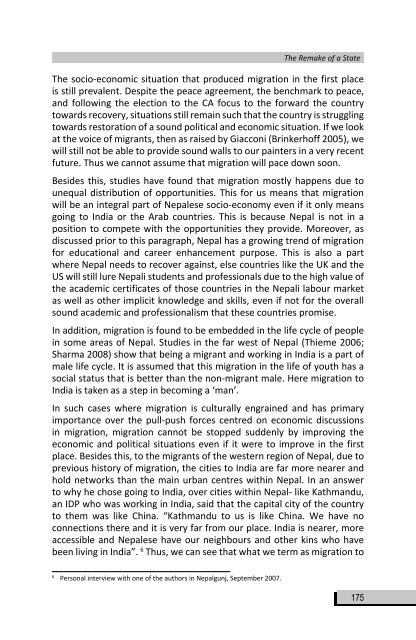English - Support to Participatory Constitution Building in Nepal ...
English - Support to Participatory Constitution Building in Nepal ...
English - Support to Participatory Constitution Building in Nepal ...
You also want an ePaper? Increase the reach of your titles
YUMPU automatically turns print PDFs into web optimized ePapers that Google loves.
The Remake of a StateThe socio-economic situation that produced migration <strong>in</strong> the first placeis still prevalent. Despite the peace agreement, the benchmark <strong>to</strong> peace,and follow<strong>in</strong>g the election <strong>to</strong> the CA focus <strong>to</strong> the forward the country<strong>to</strong>wards recovery, situations still rema<strong>in</strong> such that the country is struggl<strong>in</strong>g<strong>to</strong>wards res<strong>to</strong>ration of a sound political and economic situation. If we lookat the voice of migrants, then as raised by Giacconi (Br<strong>in</strong>kerhoff 2005), wewill still not be able <strong>to</strong> provide sound walls <strong>to</strong> our pa<strong>in</strong>ters <strong>in</strong> a very recentfuture. Thus we cannot assume that migration will pace down soon.Besides this, studies have found that migration mostly happens due <strong>to</strong>unequal distribution of opportunities. This for us means that migrationwill be an <strong>in</strong>tegral part of <strong>Nepal</strong>ese socio-economy even if it only meansgo<strong>in</strong>g <strong>to</strong> India or the Arab countries. This is because <strong>Nepal</strong> is not <strong>in</strong> aposition <strong>to</strong> compete with the opportunities they provide. Moreover, asdiscussed prior <strong>to</strong> this paragraph, <strong>Nepal</strong> has a grow<strong>in</strong>g trend of migrationfor educational and career enhancement purpose. This is also a partwhere <strong>Nepal</strong> needs <strong>to</strong> recover aga<strong>in</strong>st, else countries like the UK and theUS will still lure <strong>Nepal</strong>i students and professionals due <strong>to</strong> the high value ofthe academic certificates of those countries <strong>in</strong> the <strong>Nepal</strong>i labour marketas well as other implicit knowledge and skills, even if not for the overallsound academic and professionalism that these countries promise.In addition, migration is found <strong>to</strong> be embedded <strong>in</strong> the life cycle of people<strong>in</strong> some areas of <strong>Nepal</strong>. Studies <strong>in</strong> the far west of <strong>Nepal</strong> (Thieme 2006;Sharma 2008) show that be<strong>in</strong>g a migrant and work<strong>in</strong>g <strong>in</strong> India is a part ofmale life cycle. It is assumed that this migration <strong>in</strong> the life of youth has asocial status that is better than the non-migrant male. Here migration <strong>to</strong>India is taken as a step <strong>in</strong> becom<strong>in</strong>g a ‘man’.In such cases where migration is culturally engra<strong>in</strong>ed and has primaryimportance over the pull-push forces centred on economic discussions<strong>in</strong> migration, migration cannot be s<strong>to</strong>pped suddenly by improv<strong>in</strong>g theeconomic and political situations even if it were <strong>to</strong> improve <strong>in</strong> the firstplace. Besides this, <strong>to</strong> the migrants of the western region of <strong>Nepal</strong>, due <strong>to</strong>previous his<strong>to</strong>ry of migration, the cities <strong>to</strong> India are far more nearer andhold networks than the ma<strong>in</strong> urban centres with<strong>in</strong> <strong>Nepal</strong>. In an answer<strong>to</strong> why he chose go<strong>in</strong>g <strong>to</strong> India, over cities with<strong>in</strong> <strong>Nepal</strong>- like Kathmandu,an IDP who was work<strong>in</strong>g <strong>in</strong> India, said that the capital city of the country<strong>to</strong> them was like Ch<strong>in</strong>a. “Kathmandu <strong>to</strong> us is like Ch<strong>in</strong>a. We have noconnections there and it is very far from our place. India is nearer, moreaccessible and <strong>Nepal</strong>ese have our neighbours and other k<strong>in</strong>s who havebeen liv<strong>in</strong>g <strong>in</strong> India”. 6 Thus, we can see that what we term as migration <strong>to</strong>6Personal <strong>in</strong>terview with one of the authors <strong>in</strong> <strong>Nepal</strong>gunj, September 2007.175







![g]k fnsf blntx? / gofF ;+l jwfg](https://img.yumpu.com/49483602/1/184x260/gk-fnsf-blntx-goff-l-jwfg.jpg?quality=85)



![+ljwfg;ef, /fHosf]k'g](https://img.yumpu.com/41604075/1/184x260/-ljwfgef-fhosfkg.jpg?quality=85)




